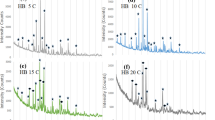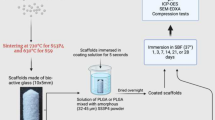Abstract
Bioactive glass scaffolds have been used to heal small contained bone defects, but their application to repairing structural bone is limited by concerns about their mechanical reliability. In the present study, the addition of an adherent polymer layer to the external surface of strong porous bioactive glass (13–93) scaffolds was investigated to improve their toughness. Finite element modeling (FEM) of the flexural mechanical response of beams composed of a porous glass and an adherent polymer layer predicted a reduction in the tensile stress in the glass with increasing thickness and elastic modulus of the polymer layer. Mechanical testing of composites with structures similar to the models, formed from 13–93 glass and polylactic acid (PLA), showed trends predicted by the FEM simulations, but the observed effects were considerably more dramatic. A PLA layer of thickness ~400 μm, equal to ~12.5% of the scaffold thickness, increased the load-bearing capacity of the scaffold in four-point bending by ~50%. The work of fracture increased by more than 10000%, resulting in a non-brittle mechanical response. These bioactive glass-PLA composites, combining bioactivity, high strength, high work of fracture and an internal architecture shown to be conducive to bone infiltration, could provide optimal implants for healing structural bone defects.














Similar content being viewed by others
References
Giannoudis PV, Dinopoulos H, Tsiridis E (2005) Bone substitutes: an update. Injury 36:S20–S27
Laurencin C, Khan Y, El-Amin SF (2006) Bone substitutes. Expert Rev Med Device 3:49–57
Gerhardt L-C, Boccaccini AR (2010) Bioactive glass and glass-ceramic scaffolds for bone tissue engineering. Materials 3:3867–3910
Rahaman MN, Day DE, Bal BS, Fu Q, Jung SB, Bonewald LF, Tomsia AP (2011) Bioactive glass in tissue engineering. Acta Biomater 7:2355–2373
Fu Q, Saiz E, Rahaman MN, Tomsia AP (2011) Bioactive glass scaffolds for bone tissue engineering: state of the art and future perspectives. Mater Sci Eng C 31:1245–1256
Jones JR (2013) Review of bioactive glass: from Hench to hybrids. Acta Biomater 9:4457–4486
Giannitelli SM, Accoto D, Trombetta M, Rainer A (2014) Current trends in the design of scaffolds for computer-aided tissue engineering. Acta Biomater 10:580–594
Deliomanli A, Rahaman MN (2012) Direct-write assembly of silicate and borate bioactive glass scaffolds for bone repair. J Eur Ceram Soc 32:3637–3646
Liu X, Rahaman MN, Hilmas GE, Bal BS (2013) Mechanical properties of bioactive glass scaffolds fabricated by robotic deposition for structural bone repair. Acta Biomater 9:7025–7034
Doiphode ND, Huang TS, Leu MC, Rahaman MN, Day DE (2011) Freeze extrusion fabrication of 13-93 bioactive glass scaffolds for bone repair. J Mater Sci Mater Med 22:515–523
Fu Q, Saiz E, Tomsia AP (2011) Bioinspired strong and highly porous glass scaffolds. Adv Funct Mater 21:1058–1063
Fu Q, Saiz E, Tomsia AP (2011) Direct ink writing of highly porous and strong glass scaffolds for load-bearing bone defects repair and regeneration. Acta Biomater 7:3547–3554
Bi L, Zobell B, Liu X, Rahaman MN, Bonewald LF (2014) Healing of critical-size segmental defects in rat femora using strong porous bioactive glass scaffolds. Mater Sci Eng C 42:816–824
Jia W, Lau GY, Huang W, Zhang C, Tomsia AP, Fu Q (2015) Bioactive glass for large bone repair. Adv Healthc Mater 4:2842–2848
Xiao W, Asle Zaeem M, Bal BS, Rahaman MN (2016) Creation of bioactive glass (13-93) scaffolds for structural bone repair using a combined finite element modeling and rapid prototyping approach. Mater Sci Eng C 68:651–662
Martinez-Vazquez FJ, Perera FH, van der Meulen I, Heise A, Pajares A, Miranda P (2013) Impregnation of β-tricalcium phosphate robocast scaffolds by in situ polymerization. J Biomed Mater Res A 101:3086–3096
Martinez-Vazquez FJ, Miranda P, Guiberteau F, Pajares A (2013) Reinforcing bioceramic scaffolds with in situ synthesized ε-polycaprolactone coatings. J Biomed Mater Res A 101:3551–3559
Martinez-Vazquez FJ, Pajares A, Guiberteau F, Miranda P (2014) Effect of polymer infiltration on the flexural behavior of β-tricalcium phosphate robocast scaffolds. Materials 7:4001–4018
Peroglio M, Gremillard L, Chevalier J, Chazeau L, Gauthier C, Hamaide T (2007) Toughening of bio-ceramics scaffolds by polymer coating. J Eur Ceram Soc 27:2679–2685
Fu Q, Saiz E, Rahaman MN, Tomsia AP (2013) Toward strong yet tough glass and ceramic scaffolds. Adv Funct Mater 23:2461–2476
Chen QZ, Boccaccini AR (2006) Poly(D, L-lactic acid) coated 45S5 Bioglass®-based scaffolds: processing and characterization. J Biomed Mater Res A 3:445–457
Day DE, Mohammadkhah A (2014) Biodegradable composite scaffold for repairing defects in load-bearing bones, U.S. Patent 20140277578A1, 18 Sept 2014
Yunos DM, Bretcanu O, Boccaccini AR (2008) Polymer-bioceramic composites for tissue engineering scaffolds. J Mater Sci 43:4433–4442
Philippart A, Boccaccini AR, Fleck C, Schubert DW, Roether JA (2015) Toughening and functionalization of bioactive ceramic and glass bone scaffolds by biopolymer coatings and infiltration: a review of the last 5 years. Expert Rev Med Devices 12:93–111
Eqtesadi S, Montealleh A, Perera FH, Pajares A, Miranda P (2016) Poly-(lactic acid) infiltration of 45S5 Bioglass® robocast scaffolds: chemical interaction and its deleterious effect in mechanical enhancement. Mater Lett 163:196–200
Korsunsky AM (2001) Encyclopedia of materials: science and technology. Pergamon, Oxford, pp 2398–2404
Liu X, Rahaman MN, Liu Y, Bal BS, Bonewald LF (2013) Enhanced bone regeneration in surface-modified and BMP-loaded bioactive glass (13-93) scaffolds in a rat calvarial defect model. Acta Biomater 9:7506–7517
Fu Q, Rahaman MN, Fu H, Liu X (2010) Silicate, borosilicate, and borate bioactive glass scaffolds with controllable degradation rate for bone tissue engineering applications. I. Preparation and in vitro degradation. J Biomed Mater Res A 95:164–171
Acknowledgement
This research was supported by the National Institutes of Health (NIDCR), Grant # 1R15DE023987-01 (Rahaman MN) and by Missouri University of Science and Technology.
Author information
Authors and Affiliations
Corresponding author
Rights and permissions
About this article
Cite this article
Xiao, W., Zaeem, M.A., Li, G. et al. Tough and strong porous bioactive glass-PLA composites for structural bone repair. J Mater Sci 52, 9039–9054 (2017). https://doi.org/10.1007/s10853-017-0777-3
Received:
Accepted:
Published:
Issue Date:
DOI: https://doi.org/10.1007/s10853-017-0777-3




